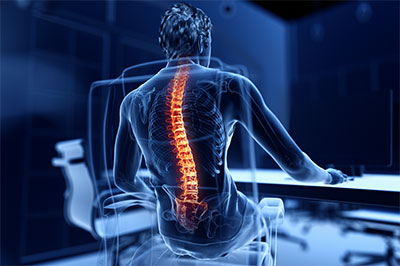Last updated November 2022

Can a Chiropractor Really Cure Your Back Pain?
Our aching backs are a big problem. According to the National Institutes of Health (NIH), it is one of the most common medical conditions, affecting 80 percent of people at some point during their lives. Each year, one in four Americans hurt so badly that they seek professional help.
There are numerous treatment options, including heat, ice, massage, stretching, yoga and similar exercises, physical therapy, acupuncture, surgery, and medication. Although back pain often is short-lived, unfortunately for many there’s no quick cure: About eight percent of U.S. adults have chronic back pain.
For years, too many patients were prescribed opioids, often at too-high dosages and for too long, which fueled our still-raging drug epidemic. As the medical community seeks to minimize use of addictive painkillers, they’re increasingly considering whether alternative medicine specialists such as chiropractors offer better solutions.
Half of Americans have seen a chiropractor at least once, mostly for back pain, according to surveys done by Gallup. But a large percentage of the populace doesn’t know what chiropractors do and isn’t sure the treatment is effective—and one in four think chiropractic care is “dangerous.”
Patients who have sought chiropractic care overwhelmingly rate their practitioners highly and report that they provide at least some pain relief. But there’s scant clinical evidence that chiropractic care is more effective at alleviating back pain than other less expensive options, including rest.
Should you consider chiropractic treatment? Maybe for back or neck pain, but first talk to your primary care doctor, and try less expensive options. Then, if you still want to take a crack at chiropractic, choose your provider carefully.
How Chiropractors Try to Treat Back Pain
Your spine is composed of a stack of small bones, called vertebrae, held together by muscles and connective ligaments and cushioned by rubbery discs. Unfortunately, this complex structure can become a real pain, thanks to aging, disease, or injury from a fall or an overly ambitious lift, twist, or over-ambitious dance move.
Chiropractors start by diagnosing each vertebral joint to identify any that are not moving as freely as they should. If they identify a problem they can treat, they usually use spinal manipulative therapy (SMT), which is applying pressure with their hands to swiftly move each stiff joint as far as it can go, plus a short distance beyond. The goal is to restore a normal range of motion and relieve pain.
 Many chiropractors use other techniques, provide additional services, and offer to treat other conditions. Examples include carpal tunnel, osteoarthritis, jaw pain, and general stiffness in the knees, ankles, shoulders, and hips. But health insurance typically covers chiropractic care only for musculoskeletal problems, said Douglas Metz, chief health services officer and executive vice president at American Specialty Health, which links health insurers to its network of chiropractors. Chiro is also not covered for things like autism, asthma, diabetes, and hypertension. “The strength of evidence is not good for those conditions,” said Metz.
Many chiropractors use other techniques, provide additional services, and offer to treat other conditions. Examples include carpal tunnel, osteoarthritis, jaw pain, and general stiffness in the knees, ankles, shoulders, and hips. But health insurance typically covers chiropractic care only for musculoskeletal problems, said Douglas Metz, chief health services officer and executive vice president at American Specialty Health, which links health insurers to its network of chiropractors. Chiro is also not covered for things like autism, asthma, diabetes, and hypertension. “The strength of evidence is not good for those conditions,” said Metz.
Chiropractors Continue to Seek Acceptance
Although chiropractors don’t go to medical school and are not physicians, to become a doctor of chiropractic (DC) they must first earn a postgraduate degree and then must get a state license to treat patients.
Like physicians, chiropractors have built an infrastructure for their profession—standards, education, licensure, and regulations. But for most of its history, chiropractic was viewed by much of the medical community as, at best, an eccentric relative. Chiropractors have spent more than 100 years trying to gain respect and a seat at the table with physicians, with modest success.
Chiropractic’s uphill battle toward wider acceptance is greatly due to the American Medical Association’s decades-long campaign against it as “quackery” (more on that below). But chiropractic is also hindered by a rather odd origin story: In 1895, Daniel David Palmer, a “magnetic healer,” claimed to have restored a deaf man’s hearing via spinal manipulation, a technique he claimed to have learned from a ghost at a séance. Two years later, he founded what is now the Palmer College of Chiropractic and the profession itself.
By that time, medical professionals were well on their way to recognizing that disease is caused by germs and pathologies, which can be remedied and often cured by science-based treatments. But Palmer insisted disease happened due to “vertebral subluxations” or displaced joints that interfered with the natural healthy flow of a “vital force” or “innate intelligence” of God that controls the entire body. He claimed this energy stream could be properly restored by simply adjusting the joints, and—voila!—the body heals itself.
Since then, medicine has made huge advances in the quality of treatments, technologies, pharmaceuticals, surgical procedures, and biomedical engineering. But the centerpiece of what chiropractors call their unique science and philosophy is still largely the same spinal manipulative therapy invented by Palmer and his followers more than 100 years ago. Although chiropractors have since adopted a science-forward approach—rather than continuing trying to explain the ghostly origins of their field—for decades the AMA worked relentlessly to marginalize chiropractors by branding them an unscientific cult. From 1963 to 1987, the AMA’s Committee on Quackery likened chiropractors to “rabid dogs [who]…killed people,” enlisted other medical professional associations to boycott chiropractors, and blocked chiropractic’s access to health insurance coverage and hospitals.
The AMA’s campaign began falling apart in the 1970s, as Medicare began covering chiropractic (but only for spinal manipulation therapy). Then, in 1987, the AMA lost an antitrust lawsuit, with the court ruling that “the AMA decided to contain and eliminate chiropractic as a profession” and that it was the AMA’s intent “to destroy a competitor.”
Chiropractors continue working toward “mainstream” status, said William Lauretti, a chiropractor and spokesperson for the American Chiropractic Association (ACA). Chiropractors can now work in hospitals, and many physicians regularly refer patients to them.
While these days most chiropractors seek to provide effective therapies grounded in science, that goal continues to get undercut by practitioners who overpromise on what they can achieve. Checkbook found chiropractors all around the U.S. advertising that their spinal manipulations can treat problems beyond the spine. To treat asthma, one Delaware chiropractor says he’ll manipulate the thoracic spine, a 12-vertebrae section with nerves that control the respiratory system. The website of a practice with franchise locations in California and four other states says its adjustments of the spine and other joints can give your body “the ability to better manage symptoms caused by fibromyalgia” and the pain of ear infections. And a South Carolina chiropractor claims he can treat 13 non-musculoskeletal conditions, including premenstrual syndrome, high blood pressure, Crohn’s disease, allergies, and even attention deficit hyperactivity disorder. For ADD/ADHD, the chiropractor says his regular adjustments of subluxations in the spine “help to ensure proper nerve flow. If a child’s spine is misaligned, it may be affecting their behavior and performance at school.”
But the NIH website warns that researchers have found too little evidence that spinal manipulation is effective for conditions that aren’t back pain, including fibromyalgia, children’s ear infections, chronic obstructive pulmonary disease, infant colic, and bedwetting. The NIH also refers to studies indicating that spinal manipulation does not help with asthma, hypertension, or menstrual pain. These warnings would be unnecessary if some chiropractors stopped making unfounded claims about their abilities.
Can Chiropractic Care Help Back Pain?
In addition to sketchy promises made by some practitioners and a bizarre history, another big reason chiropractors continue to seek widespread acceptance is that there’s not much clinical evidence that what they can do for back pain—their bread and butter—is more effective than other remedies. In general, studies have shown that chiropractors might help alleviate back pain, but other options, including rest, are probably just as beneficial. Why pay for a series of five, 10, or even more chiropractic treatments when patients can get the same relief from other options that cost less or nothing?
 The ACA website provides research supporting the field. Topping its list is a report issued in 2017 by the American College of Physicians (ACP) with evidence-based clinical practice guidelines for treating subacute back pain. Those guidelines recommended patients first try heat, massage, acupuncture, or chiropractic spinal manipulation before seeking more invasive treatment or taking prescription or over-the-counter painkillers. But the guidelines issued by the ACP also noted most back pain improves over time, regardless of treatment received. And the ACP could find only low-quality research supporting spinal manipulation by chiropractors to be an effective treatment, even though it conducted a thorough search and review of eight years of studies.
The ACA website provides research supporting the field. Topping its list is a report issued in 2017 by the American College of Physicians (ACP) with evidence-based clinical practice guidelines for treating subacute back pain. Those guidelines recommended patients first try heat, massage, acupuncture, or chiropractic spinal manipulation before seeking more invasive treatment or taking prescription or over-the-counter painkillers. But the guidelines issued by the ACP also noted most back pain improves over time, regardless of treatment received. And the ACP could find only low-quality research supporting spinal manipulation by chiropractors to be an effective treatment, even though it conducted a thorough search and review of eight years of studies.
The ACA’s website also cites a journal article that reported “some people” benefit from chiropractic, and one 2013 study that concluded manipulative therapy with standard medical care provided adults age 18 to 35 with acute low-back pain with “a significant advantage” for decreasing pain and improving physical functioning, compared to receiving standard care alone.
Chiropractic care receives severe criticism from some corners of the medical community. “Numerous clinical trials have tested the effectiveness of SMT for back pain,” writes Edzard Ernst, author of the book Chiropractic: Not All That It’s Cracked Up to Be. “Their findings are hugely contradictory. Thus, chiropractors are able to cherry-pick those results that suit them, while critics might select those studies that came out negative.”
Ernst, a physician and professor emeritus at England’s University of Exeter, has researched chiropractic and other what he brands “so-called alternative medicines (SCAMs)” for 30 years.
Ernst argues the meta-analyses done by Cochrane, an international nonprofit research organization, usually produces “the technically best and most independent systematic reviews.” We checked two of the latest Cochrane reviews for lower back pain. A 2012 review concluded that SMT by itself is no more effective in treating acute low-back pain than a placebo, sham SMT, or with standard medical care. Cochrane’s team extensively searched for and identified 20 randomly controlled SMT trials, but only one-third had high methodological quality and low risk of bias, and the team warned that the quality of evidence was low to very low.
For chronic lower back pain, a second Cochrane review published in 2013 looked at 26 controlled trials and concluded that SMT appeared to be no better or worse than other existing therapies, such as exercise, standard medical care, or physiotherapy.
Lauretti said Ernst’s criticisms are “highly biased and unreasonable.” Pressed specifically about key Ernst criticisms, Lauretti acknowledged that the core concept of the “subluxation complex” (a spinal misalignment that supposedly disrupts the transmission of the body’s natural healing power through the nervous system) “continues to be a controversial topic within the profession.” But he said spinal manipulation “has a sound scientific basis as a treatment for spinal pain, and its efficacy for other conditions continues to be a subject of scientific exploration.”
While there’s slim clinical evidence supporting chiro’s effectiveness, patients tend to love it.
In 2017, for an article in the Journal of the American Medical Association, researchers reviewed 15 controlled trials that included more than 1,700 patients studying spinal manipulation vs. other treatments. They concluded that SMT produced a clinically modest improvement in self-reported pain levels of about 10 points on a 100-point scale. The article also reviewed 12 trials of about 1,400 patients and found spinal manipulation also helped improve function.
Surveys on chiropractic by the Consumer Assessment of Healthcare Providers and Systems consistently find high patient satisfaction with their providers.
Chiropractors are also popular with Checkbook’s members. In our surveys of consumers, chiropractors are recommended about 96 percent of the time, on average, which is comparable to the average overall ratings we get for acupuncturists, massage therapists, physical therapists, and physicians.
A Consumer Reports survey of its members found that nearly 90 percent of patients who underwent spinal manipulation for back pain found it helpful.
Although chiro gets high marks from its patients, again, numerous studies indicate that their good results could have been achieved by other treatments—or even from a placebo effect. For most patients, the natural course of back pain is that it goes away no matter what they do—including if they just rest.
Clearly, more research should be done to measure the effectiveness of chiropractic care. But our lack of information and understanding of the efficacy of medical care isn’t limited to chiropractic treatment—far from it.
In a 2017 article for The New York Times, Aaron Carroll, a physician, medical school professor, and chief health officer at Indiana University notes, “Some physicians are uncomfortable that we don’t have a clear picture of how spinal manipulation actually works to reduce pain. It’s also possible that some chiropractors do it ‘better’ than others, and we can’t tell. This concern should be tempered by the fact that we don’t have a great understanding of why many other therapies work either. Some of the more traditional things we recommend don’t even work consistently.”
Further, while some physicians remain reluctant to refer patients to chiropractors for fear of potential harm, there’s little evidence or even many anecdotes that chiropractors worsen injuries—so long as they provide proper care. Other alternatives, especially surgery and prescribing opiates, can and often do cause harm in the form of complications and addiction.
Want to Try Chiro? Here Are Some Tips
The NIH says spinal manipulation is “relatively safe” when performed by a trained and licensed practitioner. The most common side effects are temporary muscle soreness, stiffness, or a temporary increase in pain. Only in very rare cases have serious complications, deaths, and delays in diagnosis of serious illnesses been associated with it.
 But first consult with your primary care physician. Because back trouble has many causes, which can be difficult to pinpoint, it’s best to get evaluated by someone with general diagnostic expertise. They might spot a problem best addressed by medical treatment that a chiropractor can’t provide. Chiropractors are legally and ethically obligated to do the same and refer problems outside their field to medical doctors. But by starting with your physician, you avoid the chance that you’ll spend weeks or months getting inappropriate chiropractic treatment and delay getting the medical care you needed all along.
But first consult with your primary care physician. Because back trouble has many causes, which can be difficult to pinpoint, it’s best to get evaluated by someone with general diagnostic expertise. They might spot a problem best addressed by medical treatment that a chiropractor can’t provide. Chiropractors are legally and ethically obligated to do the same and refer problems outside their field to medical doctors. But by starting with your physician, you avoid the chance that you’ll spend weeks or months getting inappropriate chiropractic treatment and delay getting the medical care you needed all along.
If your PCP believes seeing a chiropractor is appropriate, ask for recommendations. Also ask friends for referrals. And, of course, check reviews from consumers we surveyed.
Check with your insurer to make sure any chiro prospects participate in your network and have appropriate credentials. More than 400 health insurance plans tap into the American Specialty Health (ASH) network of 25,000 chiropractors. ASH says it validates that each provider has an active license and all appropriate credentials, no malpractice of concern, and no felonies. While these are of course fairly minimal standards to meet, you’ll at least ensure that you’ll avoid known bad actors.
You can confirm the license of any chiropractor you’re considering in the District by checking D.C. Health’s website. For Maryland, check with its State Board of Chiropractic Examiners. In Virginia, check with the Department of Health Professionals.
Confirm the license of any chiropractor you’re considering with your state’s department of health or other licensing authority; almost all have searchable databases.
The ACA’s website has its own “Find a Doctor” search tool. It lists its members, who have pledged to abide by the group’s code of ethics, which prohibits misleading patients into false or unjustified expectations or results, or misrepresenting their scope of clinical ability. But the ACA does not otherwise vet or endorse the competence of DCs in its directory.
Before making an appointment with a DC, find out what education credentials they hold and whether they have experience or specialized training to deal with your condition. Will they work collaboratively with your primary care doctor or other specialist?
During your initial visit, the chiropractor should review your health history and ask about the possible cause of your problem and where and how it hurts. The DC will examine you and may order X-rays, a CT scan, or an MRI.
The provider should then determine whether chiropractic treatment is appropriate and explain why or why not. DCs can’t prescribe meds.
Before agreeing to treatment, discuss the following points:
- How many sessions do patients with your condition generally need? For most conditions, the average is eight to 12 sessions.
- What is the timeline for care? Because some chiropractors seek to schedule an ongoing series of regular sessions, make sure to ask for clear explanations if yours recommends a long-term treatment plan.
- What are the treatment goals? If the plan is for you to regain a certain range of motion or reduction in pain in three weeks, you can monitor how well the treatment is working.
- What is the cost per session?
After spinal manipulation treatment, you might have temporary soreness, stiffness, or a temporary increase in pain.
Take Steps to Avoid Back Pain
There is much you can do to minimize back-pain problems; click here for suggestions.


